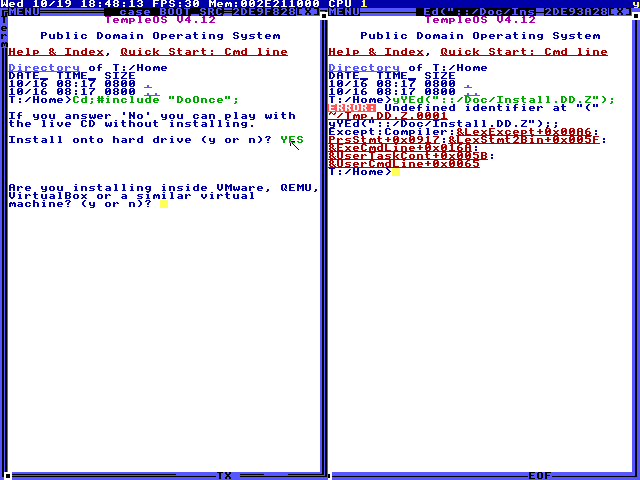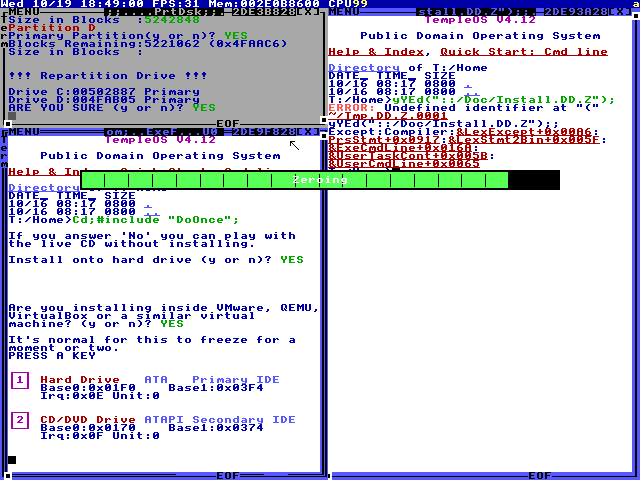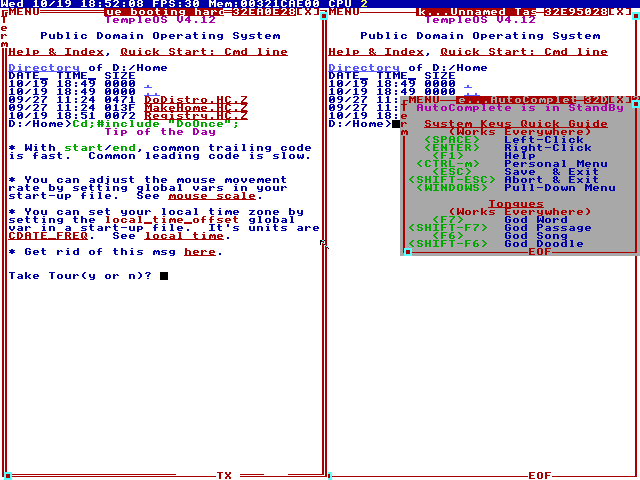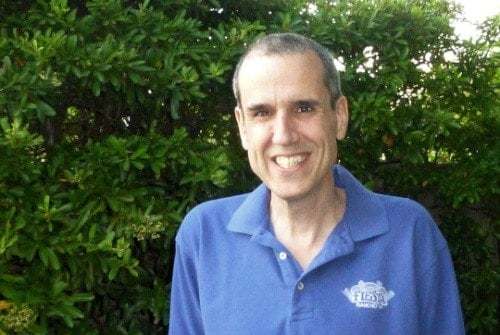TempleOS: the biblical schizophrenic operating system
The operating system distribution is tiny - only 17 megabytes. It can be quickly downloaded and tested.
The target platform is x86-64. It is unlikely that someone will experiment with a similar one as a really installed OS, so we will need any virtual machine, for example, VirtualBox or QEMU. The creator himself uses the commercial VMware Workstation. Set the virtual machine to at least half a gigabyte of memory. From the downloaded image, you can simply boot and work in LiveCD mode or install the system on a disk. Installing TempleOS is no more complicated than installing any modern operating system. You just need to press the button a few times and wait for the files to be copied.


The resulting image remotely resembles something from Commodore 64. However, the creator himself describes his creation as a modern x86_64 Commodore 64 with C instead of BASIC. So what have we just installed?

 The man on the left is Terry Davis. God chose him to create the temple, the operating system. Davis wrote the kernel, the 64-bit compiler and the operating system itself - an oracle for communicating with God.
The man on the left is Terry Davis. God chose him to create the temple, the operating system. Davis wrote the kernel, the 64-bit compiler and the operating system itself - an oracle for communicating with God.
On all the resources where Davis is present, he mixes clear and logical phrases with delirium about the machinations of the CIA, demonstrates hatred of Jews and black people. This is probably some form of coprolalia . For regular outbreaks of such sayings, he was banned in many forums, for example, on Hacker News .
A typical example of his opponents, and in general all the people who do not like him, Davis calls politically correct niggers.
Terry Davis was born in December 1969 in the family of an industrial engineer. In a large family, he was the seventh of eight children. The family often moved from place to place: Terry grew up in Wisconsin, Washington, Michigan, California and Arizona. He met Apple II in elementary school in a program for gifted children; in the early eighties, he learned the assembly language Commodore 64. Davis began writing code at school.
К 1994 году он получил сначала степень бакалавра, затем магистра электротехники в Университете штата Аризона. Какое-то время Дэвис жил в городе Темпе, где у него была работа. Студентом в 1990 году он начал писать компоненты операционной системы для продавца билетов Ticketmaster. В 1993 году у Дэвиса появилась машина с процессором 486. На ней он написал приложение для защищённого режима DOS, которое никогда не возвращало управление. Терри настроил клавиатуру для вывода символов на экран и базовую многозадачность. По сути, это был зачаток будущей операционки.
Jobs at Ticketmaster liked the former student less and less: the company transferred him to uninteresting research projects. 26-year-old Terry Davis wanted to write satellite control systems and was thinking about changing his job. In early 1996, he sent out his resume to several defense companies.
The further description of Terry's life is hard to grasp. In mid-March of the same year, he began to notice that he was being watched. Is this a check for one of these companies for which he requested a job? In Davis's head, quantum computers and conspiracy theories were mixed. He left the city south and listened to the radio, and the radio answered him. In the city of Martha (Texas), he stopped and remembered that oil companies were suppressing the development of engines on the water. He searched the car for bugs and threw keys in the desert.
This was followed by police detention, an escape, a broken collarbone, a hospital, an escape due to “artifacts” in X-rays (aliens must have planted), an attempt to hijack a pickup truck, a prison and two weeks in a psychiatric hospital. After that, Davis tried to repeat the path of Christ and gave out his possessions. Since 1996, Davis ceased to be an atheist and was constantly looking for ways to God.
In July 1996, Davis's mental state improved, he returned to Arizona. There he tried to create a three-axis milling machine - even then it was clear that the future of 3D printers. The ignition of a power tool nearly led to a fire, and Terry abandoned the idea. The prototype of the machine. This was followed by a move back to the parents ’house - Davis wanted to save some money while he was writing a sequel to Orwell’s novel 1984

". The sequel did not work out.
From 1996 to 2003, about once every six months, a new manic episode occurred. At first, doctors thought Davis had bipolar disorder , but later was diagnosed with schizophrenia . Since 2003, Davis managed to establish mental health medication. Severe attacks do not happen, although there are still strange behaviors.
Since 2003, the era of x86-64 architecture began. AMD released Opteron , the first line of microprocessors that can extend 64-bit computing and address more than 4 GB of memory with architecture extensions. And here Davis saw what technology he needed to use for his digital oracle. He took out the old DOS experiment code and got started.
Terry writes his operating system in its current form since 2003, for 13 years. Rather, he is building a temple of God in scope comparable to that of Solomon . According to the author , God said to create a temple with a resolution of 640 × 480 pixels in 16 colors. The meager palette and low resolution help avoid the need to write graphics device drivers for hardware acceleration. The Lord told Davis that sound requires one voice with different waveforms. God also asked the temple to be perfect, so Davis made the OS simple. During the development period, the system changed many names: Doors, Davos, J, LoseThos, SparrowOS. In 2013, the current name TempleOS appeared.
Davis explains TempleOS device.
Technically, TempleOS is a multi-tasking multi-core operating system. There are no separate threads - it's like processes.
TempleOS began as an abandoned 1993 project for DOS, but was brought to the level of independent OSes. Gradually, Davis wrote his own bootloader, the need to boot into FreeDOS disappeared. The OS itself did not start as a temple, the author came to this with time.
Source codes are open and free as public domain. The OS fundamentally lacks support for the network and generally any devices. It has a basic minimum for what is called an OS. All applications run in ring 0, with the highest priority, without memory protection. There is no page swapping - therefore, the OS is loaded so quickly, in a second. It is immediately available for use.
The system has a command line interface, which is implemented originally. Davis could not remember the bash commands, but he knew the syntax of C / C ++ well. Therefore, scripts are written in C, or rather, its modifications. For his OS, Davis changed the standard C and named the resulting HolyC ("holy si"). Comics in the assembly system. With the exception of low levels, where there is a language of 64-bit assembler, the whole system is written in this HolyC. It is different from the usual. No , everything that is written is being implemented. All TempleOS code is JIT compiled on request. If you type

The system reminds that it is a digital oracle. Davis used to toss a coin and pick a random number to open the Bible, read a passage, and interpret it. In TempleOS anywhere, pressing F7 will bring a random word. If you press F7 several times, you get a piece of text in which you can search for meaning. Shift + F7 will produce a fragment of the Bible.
Throughout the system, there are auto-completion tips that are available by Ctrl + F1. All sources are indexed. Shell - a hypertext document of the developed DolDoc format. Images, sprites (including three-dimensional ones) and macro are embedded in it. In the system everywhere you can open the sprite editor and paste them into any document. The documents themselves are saved.

Clicking on the rectangles will open the source file referenced.
The Red Sea file system is unique. According to the author, something had to be done that would not threaten the court. The file manager is invoked by Ctrl + D, although if desired, the user can do without it by entering the contents of the current directory
The system has several applications written by the author. Due to language differences, applications need to be rewritten, not just ported. Davis is likely to remain the only person to write under TempleOS. So far, only one case is known when another developer showed interest in the platform. But even this enthusiast looked at TempleOS asalien computer .
By generating pseudo-random numbers, AfterEgypt allows you to communicate with God. It is only necessary to find a burning thorn bush. The appendix describes the time span after Moses left Egypt.
Flight simulator and first-person shooter. In the latter, the influence of Wolftenstein is noticeable.
An application for writing music.
Davis continues to develop. He regularly broadcasts videos on YouTube and releases new versions of his OSes.
You can laugh and poke your finger, considering Davis useless crazy with no use OS. On the other hand, even if one does not turn a blind eye to the religiosity of the project, this is an interesting research work. It has its own characteristics and, possibly, convenience. The document approach is reminiscent of Xerox Alto , Oberon, and Plan 9 . TempleOS strangely borders on the capabilities of modern computing machines and the principles of the Apple II and Commodore 64 era.
The target platform is x86-64. It is unlikely that someone will experiment with a similar one as a really installed OS, so we will need any virtual machine, for example, VirtualBox or QEMU. The creator himself uses the commercial VMware Workstation. Set the virtual machine to at least half a gigabyte of memory. From the downloaded image, you can simply boot and work in LiveCD mode or install the system on a disk. Installing TempleOS is no more complicated than installing any modern operating system. You just need to press the button a few times and wait for the files to be copied.

y
The resulting image remotely resembles something from Commodore 64. However, the creator himself describes his creation as a modern x86_64 Commodore 64 with C instead of BASIC. So what have we just installed?

Terry Davis
 The man on the left is Terry Davis. God chose him to create the temple, the operating system. Davis wrote the kernel, the 64-bit compiler and the operating system itself - an oracle for communicating with God.
The man on the left is Terry Davis. God chose him to create the temple, the operating system. Davis wrote the kernel, the 64-bit compiler and the operating system itself - an oracle for communicating with God. On all the resources where Davis is present, he mixes clear and logical phrases with delirium about the machinations of the CIA, demonstrates hatred of Jews and black people. This is probably some form of coprolalia . For regular outbreaks of such sayings, he was banned in many forums, for example, on Hacker News .
A typical example of his opponents, and in general all the people who do not like him, Davis calls politically correct niggers.
Terry Davis was born in December 1969 in the family of an industrial engineer. In a large family, he was the seventh of eight children. The family often moved from place to place: Terry grew up in Wisconsin, Washington, Michigan, California and Arizona. He met Apple II in elementary school in a program for gifted children; in the early eighties, he learned the assembly language Commodore 64. Davis began writing code at school.
К 1994 году он получил сначала степень бакалавра, затем магистра электротехники в Университете штата Аризона. Какое-то время Дэвис жил в городе Темпе, где у него была работа. Студентом в 1990 году он начал писать компоненты операционной системы для продавца билетов Ticketmaster. В 1993 году у Дэвиса появилась машина с процессором 486. На ней он написал приложение для защищённого режима DOS, которое никогда не возвращало управление. Терри настроил клавиатуру для вывода символов на экран и базовую многозадачность. По сути, это был зачаток будущей операционки.
Jobs at Ticketmaster liked the former student less and less: the company transferred him to uninteresting research projects. 26-year-old Terry Davis wanted to write satellite control systems and was thinking about changing his job. In early 1996, he sent out his resume to several defense companies.
The further description of Terry's life is hard to grasp. In mid-March of the same year, he began to notice that he was being watched. Is this a check for one of these companies for which he requested a job? In Davis's head, quantum computers and conspiracy theories were mixed. He left the city south and listened to the radio, and the radio answered him. In the city of Martha (Texas), he stopped and remembered that oil companies were suppressing the development of engines on the water. He searched the car for bugs and threw keys in the desert.
This was followed by police detention, an escape, a broken collarbone, a hospital, an escape due to “artifacts” in X-rays (aliens must have planted), an attempt to hijack a pickup truck, a prison and two weeks in a psychiatric hospital. After that, Davis tried to repeat the path of Christ and gave out his possessions. Since 1996, Davis ceased to be an atheist and was constantly looking for ways to God.
In July 1996, Davis's mental state improved, he returned to Arizona. There he tried to create a three-axis milling machine - even then it was clear that the future of 3D printers. The ignition of a power tool nearly led to a fire, and Terry abandoned the idea. The prototype of the machine. This was followed by a move back to the parents ’house - Davis wanted to save some money while he was writing a sequel to Orwell’s novel 1984

". The sequel did not work out.
From 1996 to 2003, about once every six months, a new manic episode occurred. At first, doctors thought Davis had bipolar disorder , but later was diagnosed with schizophrenia . Since 2003, Davis managed to establish mental health medication. Severe attacks do not happen, although there are still strange behaviors.
Since 2003, the era of x86-64 architecture began. AMD released Opteron , the first line of microprocessors that can extend 64-bit computing and address more than 4 GB of memory with architecture extensions. And here Davis saw what technology he needed to use for his digital oracle. He took out the old DOS experiment code and got started.
TempleOS
Terry writes his operating system in its current form since 2003, for 13 years. Rather, he is building a temple of God in scope comparable to that of Solomon . According to the author , God said to create a temple with a resolution of 640 × 480 pixels in 16 colors. The meager palette and low resolution help avoid the need to write graphics device drivers for hardware acceleration. The Lord told Davis that sound requires one voice with different waveforms. God also asked the temple to be perfect, so Davis made the OS simple. During the development period, the system changed many names: Doors, Davos, J, LoseThos, SparrowOS. In 2013, the current name TempleOS appeared.
Davis explains TempleOS device.
Technically, TempleOS is a multi-tasking multi-core operating system. There are no separate threads - it's like processes.
TempleOS began as an abandoned 1993 project for DOS, but was brought to the level of independent OSes. Gradually, Davis wrote his own bootloader, the need to boot into FreeDOS disappeared. The OS itself did not start as a temple, the author came to this with time.
Source codes are open and free as public domain. The OS fundamentally lacks support for the network and generally any devices. It has a basic minimum for what is called an OS. All applications run in ring 0, with the highest priority, without memory protection. There is no page swapping - therefore, the OS is loaded so quickly, in a second. It is immediately available for use.
The system has a command line interface, which is implemented originally. Davis could not remember the bash commands, but he knew the syntax of C / C ++ well. Therefore, scripts are written in C, or rather, its modifications. For his OS, Davis changed the standard C and named the resulting HolyC ("holy si"). Comics in the assembly system. With the exception of low levels, where there is a language of 64-bit assembler, the whole system is written in this HolyC. It is different from the usual. No , everything that is written is being implemented. All TempleOS code is JIT compiled on request. If you type

main()#includefrom the command line, the specified program will be launched in the shell namespace. The system reminds that it is a digital oracle. Davis used to toss a coin and pick a random number to open the Bible, read a passage, and interpret it. In TempleOS anywhere, pressing F7 will bring a random word. If you press F7 several times, you get a piece of text in which you can search for meaning. Shift + F7 will produce a fragment of the Bible.
Throughout the system, there are auto-completion tips that are available by Ctrl + F1. All sources are indexed. Shell - a hypertext document of the developed DolDoc format. Images, sprites (including three-dimensional ones) and macro are embedded in it. In the system everywhere you can open the sprite editor and paste them into any document. The documents themselves are saved.

Clicking on the rectangles will open the source file referenced.
The Red Sea file system is unique. According to the author, something had to be done that would not threaten the court. The file manager is invoked by Ctrl + D, although if desired, the user can do without it by entering the contents of the current directory
Dir;and clicking on file hyperlinks. Expected file access protection is not expected - there is only one user. The system has several applications written by the author. Due to language differences, applications need to be rewritten, not just ported. Davis is likely to remain the only person to write under TempleOS. So far, only one case is known when another developer showed interest in the platform. But even this enthusiast looked at TempleOS asalien computer .
By generating pseudo-random numbers, AfterEgypt allows you to communicate with God. It is only necessary to find a burning thorn bush. The appendix describes the time span after Moses left Egypt.
Flight simulator and first-person shooter. In the latter, the influence of Wolftenstein is noticeable.
An application for writing music.
Davis continues to develop. He regularly broadcasts videos on YouTube and releases new versions of his OSes.
You can laugh and poke your finger, considering Davis useless crazy with no use OS. On the other hand, even if one does not turn a blind eye to the religiosity of the project, this is an interesting research work. It has its own characteristics and, possibly, convenience. The document approach is reminiscent of Xerox Alto , Oberon, and Plan 9 . TempleOS strangely borders on the capabilities of modern computing machines and the principles of the Apple II and Commodore 64 era.
